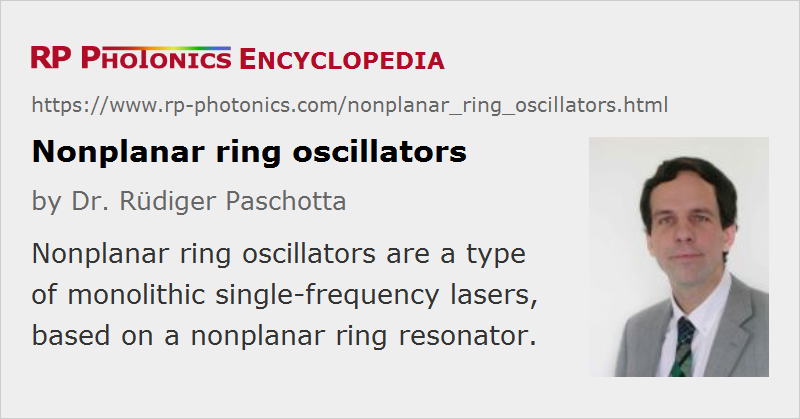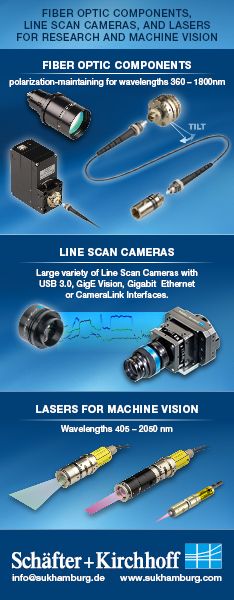Nonplanar Ring Oscillators
Acronym: NPRO; alternative: MISER = monolithic isolated single-mode end-pumped ring
Definition: a type of monolithic single-frequency lasers, based on a nonplanar ring resonator
More general term: monolithic solid-state lasers
German: nichtplanare Ringoszillatoren, nichtplanare Ringlaser
Categories: optical resonators, lasers
How to cite the article; suggest additional literature
Author: Dr. Rüdiger Paschotta
A nonplanar ring oscillator is a laser oscillator with a special monolithic design, which is very stable, compact and rugged. The resonator of an NPRO laser (Figure 1) consists of a single laser crystal (typically made of Nd:YAG) within which the laser light circulates. On one of the internal surfaces (the front face, which can have a slightly convex shape), there is a partially reflective dielectric mirror coating which is highly transmissive for the pump light (blue beam) and serves as the output coupler mirror of the resonator. On all other internal surfaces, total internal reflection occurs.

Such lasers have originally been called MISERs = monolithic isolated single-mode end-pumped rings, but later the term NPRO = nonplanar ring oscillator became more common.
An important detail is that the ring resonator of an NPRO is nonplanar. This causes a slight rotation of the polarization direction in each round-trip. If a small magnet is attached to the laser crystal, its magnetic field can cause an additional polarization rotation via the Faraday effect. For one of the two oscillation directions, the two polarization rotations partly cancel, leading to a lower optical loss when the beam hits the output coupler face of the crystal (because the coating has a slightly polarization-dependent reflectivity). The other oscillation direction leads to a higher loss and is thus firmly suppressed. In this way, one easily obtains unidirectional operation, thus avoiding any standing-wave patterns (except very near to the reflection points), which would cause spatial hole burning. For this reason, with nonplanar ring oscillators one easily obtains stable single-frequency operation.
Most NPROs are made of Nd:YAG. It is possible, however, to use other materials, such as Yb:YAG. In that case, reabsorption losses in unpumped regions can be eliminated by using a composite laser crystal, consisting of Yb:YAG and undoped YAG pieces which are bonded to each other.
Given that the round-trip length is short (typically between a few centimeters and 10 cm), the NPRO cavity has a relatively large free spectral range, which allows for continuous (mode-hope free) frequency tuning over several gigahertz. Tuning can be achieved with a piezoelectric transducer pressing on the crystal, by changing the crystal temperature with a Peltier element, or by adjusting the pump power. There have also been nonplanar ring lasers containing an electro-optic crystal for tuning.
Due to the stable mechanical setup, the low optical losses of the laser resonator and the low noise of a laser diode as pump source, the laser noise of an NPRO can be very small. Typical linewidths are in the region of a few kilohertz. Output powers up to several watts have been achieved. NPROs are often used as master lasers for high-power single-frequency MOPA devices.
Suppliers
The RP Photonics Buyer's Guide contains 3 suppliers for nonplanar ring oscillators.
Questions and Comments from Users
Here you can submit questions and comments. As far as they get accepted by the author, they will appear above this paragraph together with the author’s answer. The author will decide on acceptance based on certain criteria. Essentially, the issue must be of sufficiently broad interest.
Please do not enter personal data here; we would otherwise delete it soon. (See also our privacy declaration.) If you wish to receive personal feedback or consultancy from the author, please contact him e.g. via e-mail.
By submitting the information, you give your consent to the potential publication of your inputs on our website according to our rules. (If you later retract your consent, we will delete those inputs.) As your inputs are first reviewed by the author, they may be published with some delay.
Bibliography
| [1] | T. J. Kane and R. L. Byer, “Monolithic, unidirectional single-mode ring laser”, Opt. Lett. 10 (2), 65 (1985), doi:10.1364/OL.10.000065 |
| [2] | A. C. Nilsson et al., “Eigenpolarization theory of monolithic nonplanar ring oscillators”, IEEE J. Quantum Electron. 25 (4), 767 (1989), doi:10.1109/3.17343 |
| [3] | N. M. Sampas et al., “Long-term stability of two diode-laser-pumped nonplanar ring lasers independently stabilized to two Fabry–Pérot interferometers”, Opt. Lett. 18 (12), 947 (1993), doi:10.1364/OL.18.000947 |
| [4] | C. C. Harb et al., “Suppression of the intensity noise in a diode-pumped neodymium:YAG nonplanar ring laser”, IEEE J. Quantum Electron. 30 (12), 2907 (1994), doi:10.1109/3.362718 |
| [5] | I. Freitag et al., “Power scaling of diode-pumped monolithic Nd:YAG lasers to output powers of several watts”, Opt. Commun. 115, 511 (1995), doi:10.1016/0030-4018(95)00020-9 |
| [6] | E. J. Zang, “Single-frequency 1.25 W monolithic lasers at 1123 nm”, Opt. Lett. 32 (3), 250 (2007), doi:10.1364/OL.32.000250 |
| [7] | B. Yao et al., “7.3 W of single-frequency output power at 2.09 μm from an Ho:YAG monolithic nonplanar ring laser”, Opt. Lett. 33 (18), 2161 (2008), doi:10.1364/OL.33.002161 |
See also: lasers, ring lasers, ring resonators, single-frequency operation, single-frequency lasers, microchip lasers
and other articles in the categories optical resonators, lasers
 |






If you like this page, please share the link with your friends and colleagues, e.g. via social media:
These sharing buttons are implemented in a privacy-friendly way!